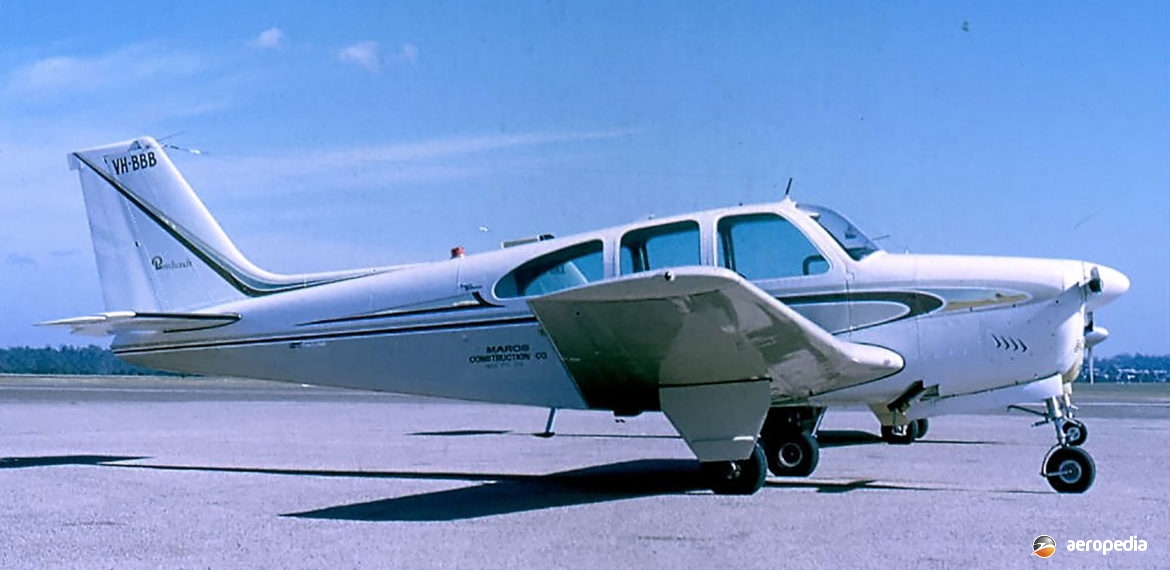Photograph:
Beech C33 Debonair VH-BBB (c/n CD-891) at Archerfield, QLD in October 1969 (David C Eyre)
Country of origin:
United States of America
Description:
Four-seat cabin monoplane
Power Plant:
One 168 kw (one 225 hp) Continental IO-470-J six-cylinder horizontally-opposed air-cooled engine
Specifications:
- Wingspan: 10 m (32 ft 3 in)
- Length: 7.77 m (25 ft 6 in)
- Height: 2.5 m (8 ft 3 in)
- Wing area: 16.5 m² (177.6 sq ft)
- Max speed at sea level: 314 km/h (195 mph)
- Cruising speed at 75% power at 2,134 m (7,000 ft): 297 km/h (185 mph)
- Cruising speed at 65% power at 3,353 m (11,000 ft): 290 km/h (180 mph)
- Economical cruising speed at 45% power at 23,058 m (10,000 ft): 230 km/h (143 mph)
- Rate of climb at sea level: 308 m/min (1,010 ft/min)
- Service ceiling: 6,035 m (19,800 ft)
- Stalling speed: 97 km/h (60 mph)
- Range at economical cruising speed at 3,048 m (10,000 ft): 1,360 km (845 miles)
- Range with max fuel of 257 litres (56.5 Imp gals): 1,883 km (1,170 miles)
- Empty weight: 785 kg (1,730 lb)
- Loaded weight: 1,315 kg (2,900 lb)
History:
The Beechcraft 33 Debonair was a four-seat, high-performance, all-metal, low-wing cantilever monoplane with a fully retractable tricycle undercarriage. The prototype was flown for the first time on 14 September 1959. Basically similar to the Model 35 Bonanza, using the fuselage and wings of the Model J35, the main difference was the conventional tail assembly in place of the ‘V’ tail of the Bonanza series. It was regarded as a more basic model of the Bonanza.
During the years 1959 to 1967, the Debonair was produced in a number of variants, the name ‘Debonair’ eventually being dropped in 1967, and both the ‘V’ tailed and the conventional tailed models being named Bonanza.
Some 2,230 Model 33 Debonairs were produced. Initial model was the 33 and during the first year of production, 1961, 233 were delivered. The A33 appeared in 1961 and had revised aileron and elevator trim tab systems, larger rear windows, and cabin trim altered. The B33 in 1962 had an IO-470-K engine and some other small modifications, including an increase in the fuel capacity.
In 1966 the C33A was added to the range. The C33, which received type approval in December 1964, went into production in 1965 and had a 168 kw (225 hp) Continental IO-470-J six-cylinder engine and a max weight of 1,315 kg (2,900 lb). The C33A followed in 1966-1967 with a 212 kw (285 hp) Continental IO-520-B engine, having a max weight of 1,497 kg (3,300 lb) and two extra seats in the rear of the cabin as an option but these could only carry small children. The C33 and C33A models continued in production until late 1967 when new models appeared, the E33 and E33A which had an increase in wingspan and had 168 kw (225 hp) and 212 kw (285 hp) engines respectively.
New aircraft from 1967 onwards became known as the E33B and E33C, these being the E33 and E33A strengthened so they could perform some aerobatics; and the F33 having an IO-470-K engine and being discontinued during 1971. In that year the cabin length was increased by 0.48 m (18.8 in). Those with the 213 kw (285 hp) engine had the suffix ‘A’ added to the model number (eg the F33A).
In 1972 the Model G33 was first introduced to the range, with a 194 kw (260 hp) Continental IO-470D engine. Thus, three engines were available in the series. An aerobatic model was produced as the F33C.
The Debonair was described by the manufacturer in advertising as “the finest combination of strength, range, performance, reliability. All metal construction, rugged, retractable undercarriage. Range over 1000 miles. 185 mph cruising speed. Efficient new ring type braking. Quiet luxurious, reliable flying for up to four people…all these and more Beechcraft features at a down-to-earth price”.
Australian distributor was Hawker de Havilland Australia Pty Ltd at Bankstown, NSW. Some 33 examples of the 33 series have appeared on the Australian register; and one 35-C33A has appeared on the New Zealand register.

